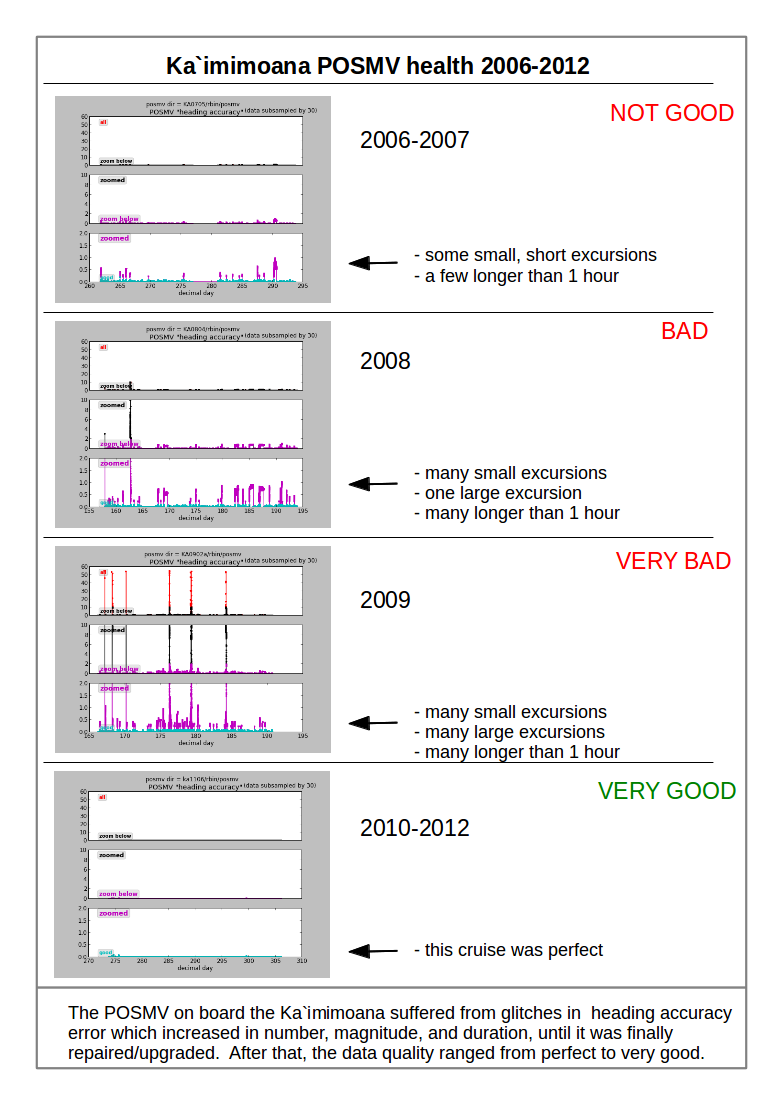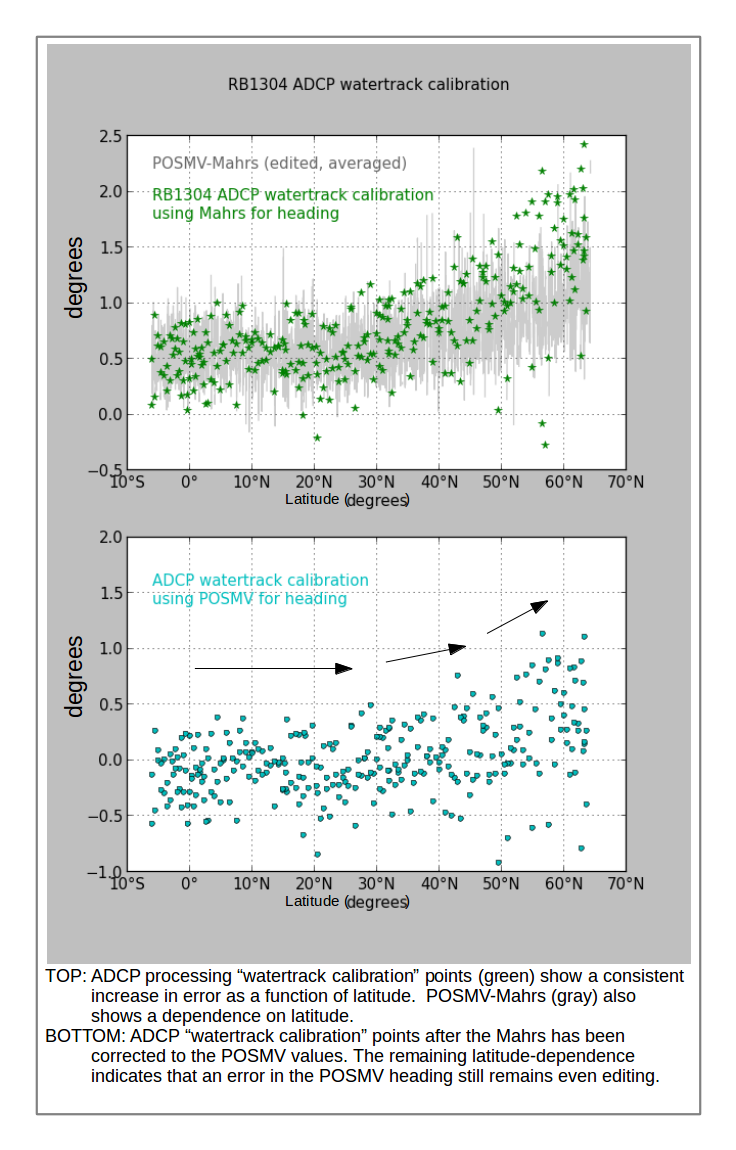POSMV Errors¶
Reliability¶
Headings from the POSMV on the Ron Brown are often bad, i.e. suffer from reduced accuracy. The POSMV’s $PASHR message provides attitude and several error indicators. The most useful from a practical and diagnostic perspective is the floating point “heading accuracy”. Grammatically, this value should be thought of as “heading accuracy error”, i.e. the larger the value, the larger the error.
If the only recorded message was the $HEHDT string, one might think the POSMV was reliable. POSMV headings can be off by up to several degrees, but at a quick glance, one would never know. Only by recording and using the $PASHR message can we begin to assess the reliability of the POSMV.
Accuracy¶
The POSMV should be a more accurate device than the Mahrs, because it is using a 2-GPS array to calculate heading relative to the satellite constellation. Unfotunately the POSMV on the Ron Brown is not healthy. It frequently loses its GAMS (GPS) solution, and with it, usable accuracy.
Experience shows that
- the POSMV heading is likely to be degraded when this “heading accuracy” parameter deviates from its minimum possible value
- The longer the “heading accuracy” excursion away from its baseline, the larger the heading error
- the numerical value of the “heading accuracy” parameter is not in degrees: it underestimates the actual heading error by large and variable amounts
- the “heading accuracy” parameter is the only reasonable parameter to use for editing out bad headings
On the Ron Brown, the minimum value for the “heading accuracy” parameter is 0.0190; this value is set by the distance between the GPS antennas. Most deviations from the minimum are associated with GAMS solution failures and loss of heading accuracy. Long excursions are particularly bad, because they create holes in the accurate heading that are too long to interpolate across, relative to the 84-minute cycle of a Shuler oscillation. Any time the POSMV has a long gap (longer than 15min) it significantly degrades the ocean velocities calculated from ADCP data any time the ship is underway.
The next figure shows the “heading accuracy” parameter for leg 1, zoomed in on three vertical scales. There are several things to note:
- there are many excursions (bottom panel, pink fingers)
- maximum duration is about 1 hour
- maximum “heading accuracy” parameter is less than 2, but heading errors can be several degrees (see below)
- 20%-50% of the data are affected by these excursions (depending on threshold used to identify a glitch)

Now compare this to four similar images from the Ka`imimoana. The Ka`imimoana POSMV worked pretty well from 2006-2007, with only a few small excursions on most cruises. In 2008, performace degraded, with lengthy excursions eliminating important chunks of accurate heading during each cruise. In 2009 the performance was so bad that the POSMV was basically useless, compromising an entire season of ADCP data. The POSMV was repaired/upgraded in the fall of 2010 and the performance improved dramatically. There were still small excursions, but it was quite useable. Another tweak was made and during the last few years the ship operated, the POSMV finally worked very well.

POSMV quality plots from earlier Ron Brown cruises (2011, 2012) show that ever since it was installed, the number of excursions has been quite high. On one early cruise, GAMS was lost for the entire cruise (bad heading values for the whole cruise). Fortunately, it has not gotten as bad as the Ka`imimoana POSMV was when that unit finally recieved proper care, but it is likely that the Ron Brown POSMV will degrade over time, not spontaneously improve.
It is important to see the connection between the excursions in the POSMV “heading accuracy” parameter and actual POSMV heading errors. For this purpose, the Mahrs is good enough to use in comparison. The next figure shows the “heading accuracy (error)” (top panel) and the difference between the POSMV and Mahrs heading (second panel), without any QC applied to the POSMV. Note that the large excursions in “heading accuracy” parameter correctly indicate an increase in POSMV heading error as compared to the Mahrs. These periods are noted with black bars under them. NOTE that the excursions in this figure range from 0.6-1.4, but the actual heading errors compared to the Mahrs are as much as 3 degrees.

Is a “heading accuracy” threshold sufficient to edit out the bad headings? The third panel shows the remaining values if a “heading accuracy” cutoff of 0.0205 is used to exclude bad POSMV values. The minimum values are (0.0190, 0.020, 0.021,...). Choosing 0.0205 allows the lowest two values to pass as “good”. The effect of threshold editing using the “heading accuracy” is dramatic and positive. In the third panel, the black curve shows what remains after using the 0.0205 cutoff. The large heading errors are gone.
But this is not sufficient: note that each of the three positive POSMV-Mahrs devations each have a upward “ramp” at the beginning of the excursion. It is common for the POSMV to have obvious heading errors while the “heading accuracy” parameter has only begun to drift away from the minimum value.
The fourth panel shows the effect of eliminating all data unless the “heading accuracy” parameter is equal to the absolute minimum possible. This helps, but is still not good enough. For this POSMV, in addition to requiring that the “heading accuracy” not deviate from the absolute minimum, it is also necessary to further “trim” the good data by expanding the edited sections. “Trimming” of 800sec seems to be important for large excursions; less so for small excursions. For some POSMVs it is only required before the onset of the excursion (not at the end).
Given the variety of error behaviors we have seen on POSMVs, it is not possible to have automated editing scheme that is sufficient to reliably remove bad headings from unhealthy instruments. Therefore, on the Brown and other ships with UHDAS, only a simple “heading accuracy” cutoff (slightly above the minimum) is used for editing.
The next figure shows a segment from 31N to 46N where the heading accuracy excursions (errors indicated in heading by the POSMV) were worst. The red values are exclude based on a 0.0195 cutoff, reducing the number of points by 30% over the course of the cruise. This step also removes most of the large positive outliers (also visible in the histograms). The black values are additionally excluded by widening the windows by 800sec on each side. This reduces the amount of good POSMV data from 70% to 55%. It is clear that this additional step is necessary, but it does reduce the remaining data.

Now we can use the ADCP data again to assess the quality of the remaining POSMV data. We do this by processing the data first with the Mahrs as the heading device, then correcting the heading by removing the gross POSMV-Mahrs latitude-dependent difference. This has the effect of using the corrected Mahrs to fill the holes in the edited POSMV data. Now the watertrack calibration values indicate whatever error is left in referenceing the ADCP to North. At this point, that error comes from the POSMV. The next figure shows this remaining error. This error should not exist in a healthy POSMV.
